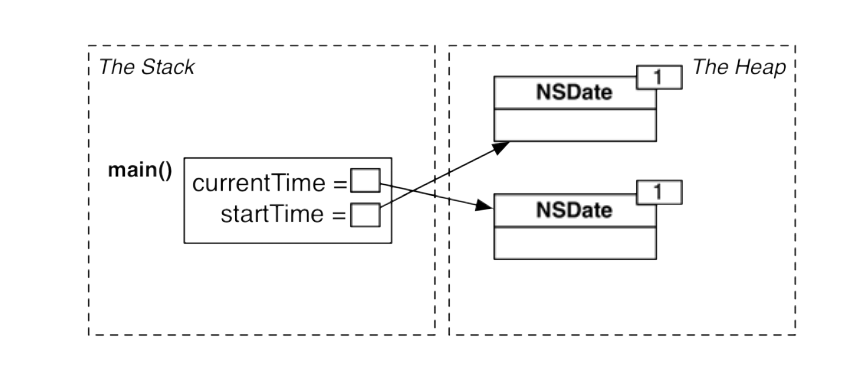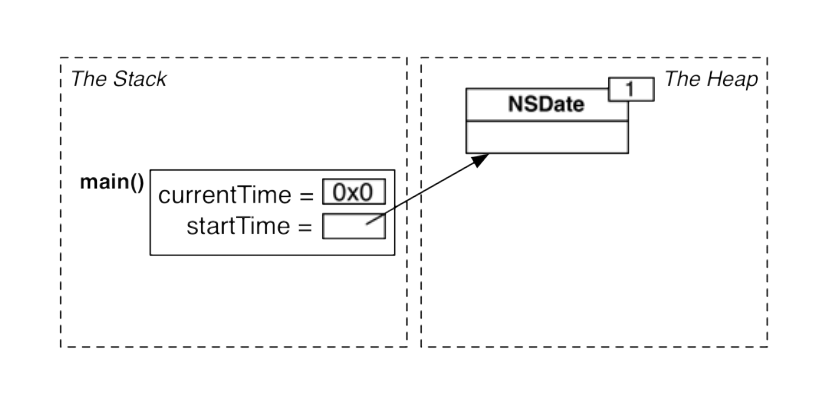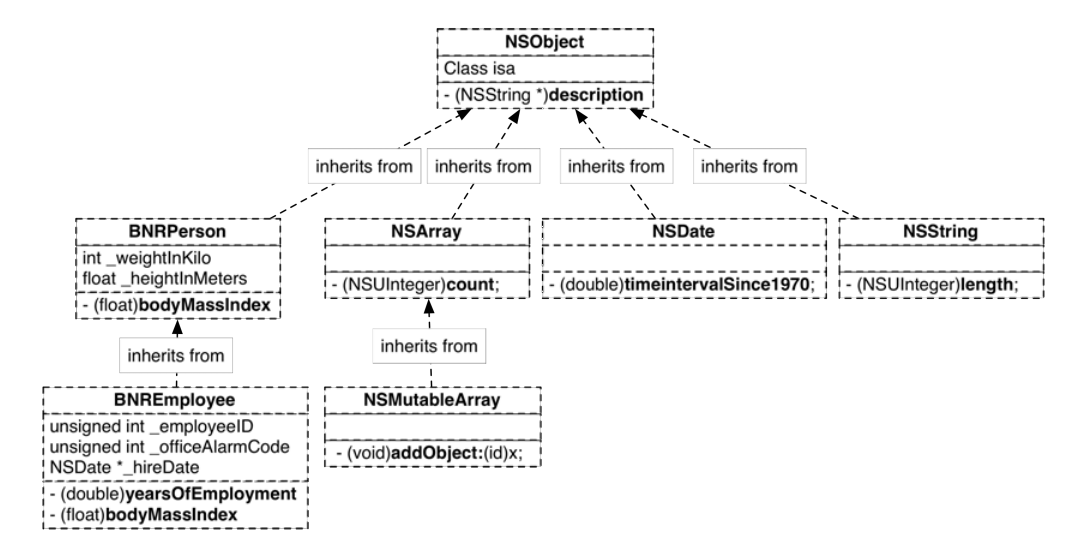iOS基础入门(二)
1.概述
这一节讲 Objective-C 语法。
学姐是看的英文书 Objective-C Programming:The Big Nerd Ranch Guide ,链接为 https://www.bignerdranch.com/we-write/objective-c-programming/ ,大家可以去买来看看。
(1) C vs. Objective-C
-
C是面向过程语言 -
Objective-C是面向对象语言,在C语言的基础上补充了面向对象特性
(2) .h 文件 vs. .m 文件
-
.h是头文件,通常在.h头文件中声明实例变量和方法 -
.m文件是实现文件,用来写代码,并实现头文件的方法
2.语法篇
2.1 import
//导入Foundation基础框架 #import <Foundation/Foundation.h> //导入头文件 #import "***.h" 这里涉及几个知识点:
-
Foundation是一个包含基础类的框架,iOS或OSX开发都需要先导入这个框架
-
<>和""的区别:<>告诉编译器Foundation/Foundation.h是Apple库中一个预编译的头;""告诉编译器在当前工程中查找***.h头文件 -
#import和#include的区别:#import更快、效率更高。原因是:#include编译器会进行一个文件内容的拷贝粘贴;#import编译器会先检查其他文件是否已经导入或包含了,若已导入则不重复导入。
2.2 Method & Message
//获取当前日期 NSDate *now = [NSDate date]; //获取当前时间距离1970年的毫秒数 double seconds = [now timeIntervalSince1970]; //传入1个参数 [now dateByAddingTimeInterval:100000]; //传入多个参数 [cal ordinalityOfUnit:NSDayCalendarUnit inUnit:NSMonthCalendarUnit forDate:now] //消息嵌套 double seconds = [[NSDate date] timeIntervalSince1970]; //发送消息给nil Dog *fido = nil; Newspaper *daily = [fido goGetTheNewspaper]; 这里涉及几个知识点:
-
两个概念:
类方法和实例方法。Line1中date是类方法,Line2中timeIntervalSince1970是实例方法 -
类方法前修饰符为
+,实例方法前修饰符为- -
调用某个方法,在iOS中叫发送消息(个人理解)。发送消息时可以传入0-N个参数
-
关于消息结构:由3个部分组成。receiver(类或类实例),selector(消息,类似于方法),argument(冒号后面的参数)。Line2、Line3和Line4分别展示了参数为0、1、2的情况。
-
关于消息嵌套:Line5为消息嵌套调用,等价于Line1-2
-
关于发送消息给nil。如Line6-7,发送消息给nil是合法的,并不会报错。给nil发送消息得到的结果是无意义的,应该被丢弃
关于alloc & init
-
alloc是给对象分配内存,init初始化对象 -
alloc是类方法,init是实例方法 -
[NSDate date]等价于[[NSDate alloc] init]
2.3 Object and Memory/Memory Leaks
NSDate *currentTime = [NSDate date]; NSDate *startTime = currentTime; sleep(2); currentTime = [NSDate date]; currentTime = nil; 上面代码片段1和2对应的内存分布情况分别如下图所示:


2.4 String & Array
(1)NSString
//创建常量String NSString *lament = @"Why me!?"; //创建含Unicode字符String NSString *slogan = @"I /u2661 New York!"; //动态创建String NSString *dateString = [NSString stringWithFormat:@"The date is %@", now]; //实例方法:获取String长度 - (NSUInteger)length; //实例方法:判断两个字符串内容是否相等 - (BOOL)isEqualToString:(NSString *)other; //实例方法:String字符大写 - (NSString *)uppercaseString; 这里涉及几个知识点:
-
字符串格式形如
@"..." -
NSString中可以包含Unicode字符,不过要在前面加
/u -
NSString几个实例方法:
stringWithFormat,length,isEqualToString,uppercaseString
(2)NSArray
//NSArray列表创建 NSDate *now = [NSDate date]; NSDate *tomorrow = [now dateByAddingTimeInterval:24.0 * 60.0 * 60.0]; NSDate *yesterday = [now dateByAddingTimeInterval:-24.0 * 60.0 * 60.0]; NSArray *dateList = @[now, tomorrow, yesterday]; //列表遍历 NSUInteger dateCount = [dateList count]; for (int i = 0; i < dateCount; i++) { NSDate *d = dateList[i]; } //旧的写法 NSArray *dateList = [NSArray arrayWithObjects:now, tomorrow, yesterday, nil]; NSDate *d = [dateList objectAtIndex:0]; //可变数组 NSMutableArray *dateList = [NSMutableArray array]; [dateList addObject:now]; [dateList addObject:tommorrow]; [dateList insertObject:yesterday atIndex:0] for (NSDate *d in dateList) { NSLog(@"Here is a date: %@", d); } 这里涉及几个知识点:
-
数组分为固定数组和可变数组。固定数组格式形如
@[...],只能访问不能改变,可变数组可以动态改变数组元素。 -
NSArray提供的方法:count,arrayWithObjects,objectAtIndex。arrayWithObjects必须以nil结束,表明终止。列表遍历可以使用index索引,如dateList[i] -
NSMutableArray提供的方法:array,addObject,insertObject,removeObjectAtIndex。列表遍历使用for
2.5 Instance Variables & Properties
//BNRPerson.h实例变量 @interface BNRPerson : NSObject { float _heightInMeters; int _weightInKilos; } - (float)heightInMeters; - (void)setHeightInMeters:(float)h; - (int)weightInKilos; - (void)setWeightInKilos:(int)w; @end //BNRPerson.m @implementation BNRPerson - (float)heightInMeters { return _heightInMeters; } - (void)setHeightInMeters:(float)h { _heightInMeters = h; } - (int)weightInKilos { return _weightInKilos; } - (void)setWeightInKilos:(int)w { _weightInKilos = w; } //BNRperson.h属性 @interface BNRPerson : NSObject @property (nonatomic) float heightInMeters; @property (nonatomic) int weightInKilos; @end 这里涉及几个知识点:
-
如上代码片段展示了
实例变量和属性两种表现形式,两者是等价的。 -
实例变量:在
.h文件中声明实例变量,以_开头,并声明getter/setter方法,在.m文件中实getter/setter方法 -
属性:在
.h文件中声明属性,用@property关键字表示。修饰符默认是atomic和readwrite类型。atomic和nonatomic分别是原子和非原子,区别在多线程。读写属性只能是readonly和readwrite,分别为只读和可读写。
2.6 Inheritance & Class Extensions
- (float)bodyMassIndex { float normalBMI = [super bodyMassIndex]; return normalBMI * 0.9; } 
-
通常在
.h头文件中声明实例变量和方法,.m文件继承.h文件,并实现其方法 -
使用
super关键字调用父类方法 -
NSObject有一个实例变量:isa指针,,其含义是is-a,每个对象的isa指针指向创建它的对象 -
发送一个消息给某个对象去查找某个方法时,先根据当前对象的isa指针从当前对象查找,若没有则继续从父类中查找,一直到NSObject对象为止
3.总结
Objective-C 语法书看了一半,参考了下大神 casatwy 和 txx 的建议,决定下两周做一个简单的ToDoList iOS应用程序。
嗯,不出成果,怎么证明自己会iOS呢?说出去别人也不会信,还是拿东西出来说话吧。
欢迎大家关注我的公众号:学姐的IT专栏












![[HBLOG]公众号](http://www.liuhaihua.cn/img/qrcode_gzh.jpg)

